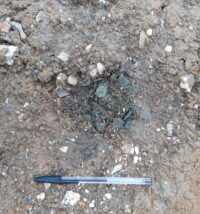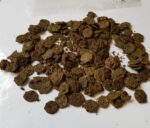 Archaeologists excavating the site of highway construction in the Hillingdon neighborhood of West London have unearthed a hoard of more than 300 rare coins from the late Iron Age. The Hillingdon Hoard was found after a rainstorm exposed a patch of greenish soil indicating the presence of oxidized metal. Upon closer examination, the team spotted slim metal discs packed in the soil which proved to potins from the 1st century B.C.
Archaeologists excavating the site of highway construction in the Hillingdon neighborhood of West London have unearthed a hoard of more than 300 rare coins from the late Iron Age. The Hillingdon Hoard was found after a rainstorm exposed a patch of greenish soil indicating the presence of oxidized metal. Upon closer examination, the team spotted slim metal discs packed in the soil which proved to potins from the 1st century B.C.

 Potins are coins made of a mixture of copper, tin and lead cast in Britain but copying an earlier Celtic coin minted 2,175 years ago in what is now Marseille. They are about 1.2 inches in diameter A stylized profile of Apollo facing left is on the obverse. A bull charging to the right is on the reverse.
Potins are coins made of a mixture of copper, tin and lead cast in Britain but copying an earlier Celtic coin minted 2,175 years ago in what is now Marseille. They are about 1.2 inches in diameter A stylized profile of Apollo facing left is on the obverse. A bull charging to the right is on the reverse.
The first series of potins produced in Britain, are known as Kentish Primary or Thurrock types, and are likely to have been made no later than 150 BC. Sometime before 100 BC, these rather bulky coins were replaced by thinner coins with more degenerate designs, now called Flat Linear types. Over a period of several decades, the Flat Linear potins gradually evolved into a wide variety of forms, with the depiction of the bull and the head of Apollo becoming more and more stylised. The Hillingdon Hoard is late in the Flat Linear sequence.
A hoard of a similar size, the ‘Sunbury hoard’ was discovered in 2010 but the potins were dated much earlier in the Iron Age. Potins from late in the Iron Age, similar to the Hillingdon Hoard, have been found previously but in much smaller quantities, making this find very significant.
 The coins have been removed to a lab for cleaning, conservation and assessment of condition. They will be catalogued and analyzed by experts to learn more about their origins. The find has been reported to the local coroner to initiate the process of determining whether the hoard qualifies as treasure. (It does, no question.)
The coins have been removed to a lab for cleaning, conservation and assessment of condition. They will be catalogued and analyzed by experts to learn more about their origins. The find has been reported to the local coroner to initiate the process of determining whether the hoard qualifies as treasure. (It does, no question.)